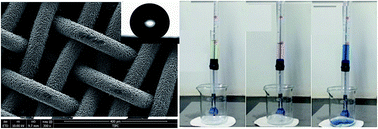Wettability and permeation of ethanol/water mixture on porous mesh surface†
Abstract
In this paper, we fabricated a series of different chemical composition and roughness copper (Cu) meshes by using a one-step self-assembly method with different mixed thiols. The wetting behavior and the permeation behavior of ethanol/water mixed solution on different meshes were studied systematically. The manipulation of the wettability and permeation of these surfaces by controlling the concentration of the ethanol/water solution and the mole fraction of HS(CH2)2OH in the modifier solution can be achieved. This work can not only help us to understand wettability of a mixture liquid on a surface, but also give us inspiration to design and fabricate new types of material for mixed liquid sensors.


 Please wait while we load your content...
Please wait while we load your content...